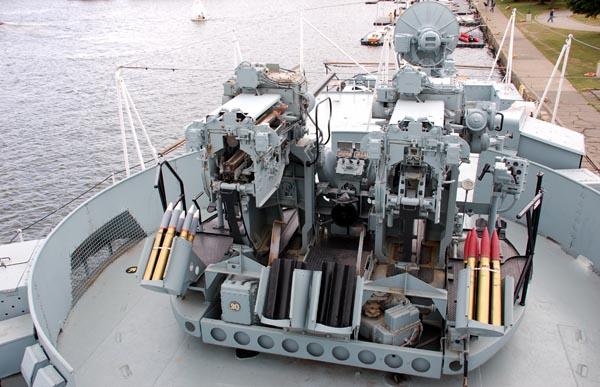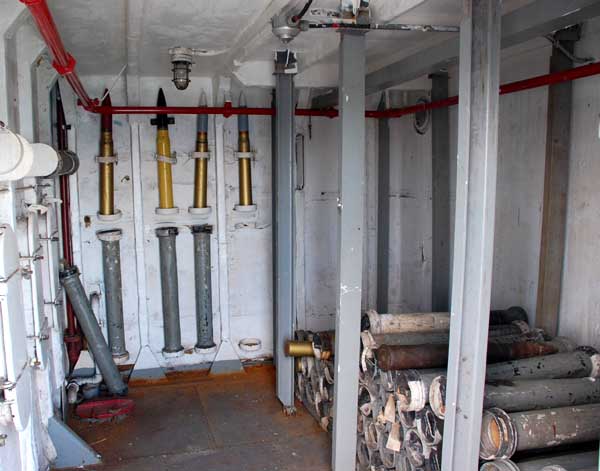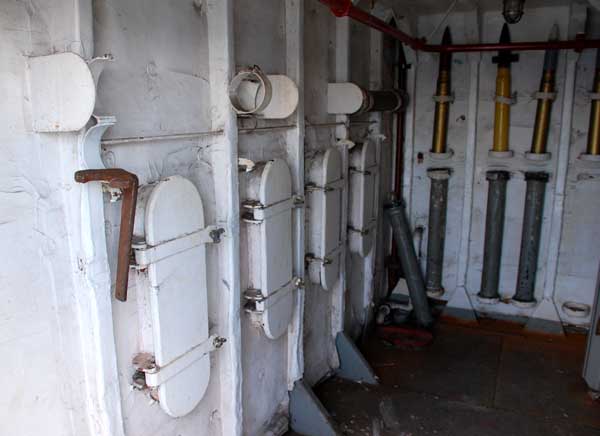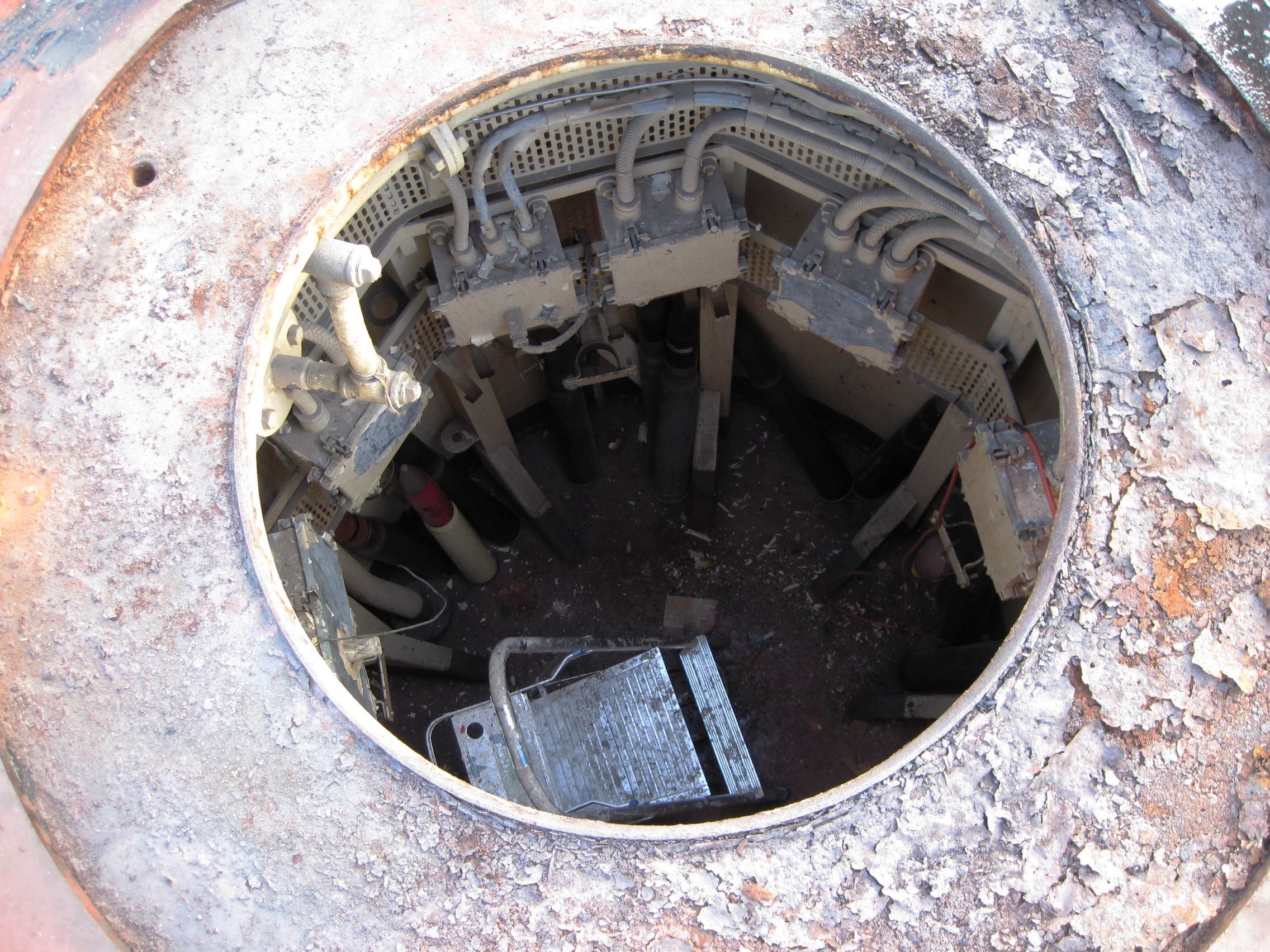 |
| The 3"50 gun could fire at the rate of 40 rounds per minute per barrel or 80 rounds per minute for the entire mount. An SPG-34 radar atop the gun measured target range which was used to calculate the "lead-off" angle of the gun. When shooting at aircraft, the gun has to fire at the place in the sky where the aircraft will be when it meets up with the round which has just been fired. The 3"50 magazine had a capacity of 1,518 rounds. (Photo by Jerry Proc) |
Prior to HAIDA'S first tour of duty in Korea, a 3" 50 gun was installed during the the conversion refit and occupies the space formerly held by the Twin Four mount or the 'X' mount of World War 2. These guns fired a round which was 3 inches in diameter. The length of the gun barrel was 150 inches, or 50 times the diameter of the round, hence the name 3" 50 calibre. This gun was designed by the US Navy primarily as an anti- aircraft gun but it could be used in a general purpose application as well. Unlike the twin, four inch guns, these guns could only be operated electrically and without manual backup.
 |
| The four "Lazy Susan" projectile carriers had to be be continuously supplied from the ready-use compartment just forward of the gun. It took a crew of 15 to operate this gun and keep it supplied with ammunition. Different colours on the projectile tips indicated different fuze types. Empty shell casings would be kicked over to each side of the gun where they fell into a wire cage. (Photo by Jerry Proc) |
During both tours of duty in Korea , the 3"50 gun was used to fire at trains which operated on the coastal railway. The US Navy, in an effort to boost morale, issued a challenge to all ships by forming an elite group called the "Trainbusters Club". Membership in the club was open to all ships. HAIDA joined in December 1952 when she scored a direct hit on the engine of a train. HAIDA'S crew proved adept at this new sport thus earning one of the top spots in the "club."BASIC SPECIFICATIONS
The 3 in 50 gun aboard HAIDA is a Mark 8 Mod 2 fitted on a MK XXI Mod 1 power mount.
Maximum barrel elevation and depression: +85 to -15 degrees
Training and laying speed: Training 30 deg/sec; laying 24 deg/sec
Rate of fire: 40 rounds per minute per barrel or 80 rounds per mount. The rate of fire was controlled by the drive motor gearing which could be changed.
Total weight of round: 24 lbs.
Weight of shell only: 13 lbs.
Maximum horizontal range at 45 degrees elevation - 14,600 yards
Maximum vertical ceiling - 29,800 feet (9,933 yards)
Fuse type: VT (proximity) and DA
Other round types: Star shell, practice round (no charge in the shell) and a bore clearing charge for the gun.
Misc: 10,000 yards was the engagement range. Accuracy also improved if the target was closer..
Pictured here is HAIDA'S 3"50 gun crew and was likely taken during one of HAIDA'S tours of duty in Korea. (HMCS HAIDA Archives photo
991.011.001.027)
 |
| Above and below: Within feet of the 3in 50 gun, this ready-use locker could accommodate 200 rounds of ammunition. This space was also used as a shelter by the gun crew. Interlocking cannisters prevented the rounds from moving around while the ship was at sea. The 3"50 magazine is the next compartment forward from the Squid magazine. Some of Boffin ammo was also stored in the 3in 50 magazine. Access to the 3in 50 magazine was through a covered manhole in the forward end of the Wardroom flats (Photos by Jerry Proc) |
 |
 |
| This is the bottom part of the 3in50 ammo hoist which is located in the 3 in 50 magazine. The top portion is in the flats just aft of the Officers Galley. |
AMPLIDYNE ROOM
Just aft of the Officers Galley on the port side, is the Amplidyne Room. When the ship was in service, bearing and elevation signals arrived here from the Mk 63 system and the amplidyne system would follow the target The room used to contain the control panel, the amplifier panel and the two amplidyne generators for the 3 in 50 guns ONLY. The control panel had all the motor starters for the system as well as all the fusing and cutouts for the system .The amplifier unit had three parts - one chassis for training , one chassis for elevation and a third for the parallax correction. The output of the generators went directly to the 3 inch 50 mount motors.The primary supply voltage was 440 volts, 3 phase. The 3 inch 50 gun had sights on the left side for aircraft targets and on the right side for surface targets. There is a switch built into the control handle that if closed, gave the operator full control of the guns which included firing them. If the mount was given full control , it cut off the signal from the control system.
An amplidyne is an electromechanical amplifier invented prior to World War II by Ernst Alexanderson. It consists of an electric motor driving a DC generator. The signal to be amplified is applied to the generator's field winding, and its output voltage is an amplified copy of the field current. The amplidyne was used in industry in high power servo and control systems, to amplify low power control signals to control powerful electric motors as one example. The amplidyne was first used in the US Navy in servo systems to control the electric motors rotating naval gun mounts and to aim the gun at a target.
 |
| None of the amplidyne equipment exists today. Instead, the room has been re-purposed to house an air bubbling system which prevents ice buildup around HAIDA's hull. (Parks Canada image) |
The amplidynes fitted aboard HAIDA were around 4 to 5 feet t long and about 18 inches in diameter. If anyone has a photo of the type found aboard the ship, please contact: jerry.proc@sympatico.ca. Even a similar photo will do.
In 2009, it was determined that the deck beneath the 3 in 50 gun needed to be replaced due to deteriorated steel. The first step was to remove the gun itself. Below are a few photos which document the activity which took place late in 2009.
| Up, up and away. The gun is being hoisted by a crane. |
| Gently does it as the gun is being lowered unto a fork lift. |
| Touchdown in HMCS Star parking lot. |
 |
| View beneath the mount |
| Here, the deck has beenr fefutnished and is awaiting the re-installation of the 3 in 50 gun. |
| All photos in this table by Neil Bell. |
References:1) http://www.dlsu.edu.ph/offices/osa/rotc/pdf/ms2/naval-ordinance-gunnery-b.pdf
2) Battle Ensign Flying by Barry Gough.
3) Jim Brewer
4) BRCN 4004
5) Neil Bell rcnr@rogers.com
Apr 7/23